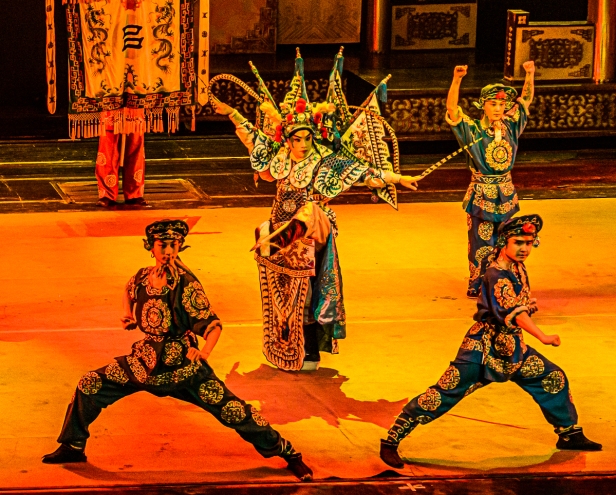
29 May 2018.
She’s standing in the aisle of the theatre a few levels up from the stage. She’s facing our row and looking right at us. I’m sitting about five seats in from the aisle and she’s right there. Her outfit is glorious, her headdress magnificent. She’s like a brightly coloured bird, a vision from some fantastical jungle, but it is her face that we are watching. It is covered in an intricately designed and beautifully coloured mask. Suddenly, with a flicker of movement so fast and infinitesimal that we cannot detect it, the mask is gone only to reveal a different one. My jaw drops, but even before there is time for that to happen the second mask is gone to reveal a third. My eyes widen. I’m paralysed with shock, intrigue, excitement, and mostly because if I move even a muscle I might miss something. And there she stands before us, moving so little that it is undetectable, revealing mask after mask, each one unique. It’s as if one mask slides instantaneously into some mysterious hiding place as another arrives. And it happens so quickly that you can’t even see the movement. There are about six different masks revealed one after the other until the last one, in the blink of an eye, disappears, and there she is, showing her true face as she smiles at us and then turns away and returns to the stage. The whole thing takes about ten seconds. Magic!
We are at a performance of the Sichuan Opera in Chengdu, and I hardly know where to start to describe one of the most extraordinary pieces of theatre I’ve ever seen. It is highly polished, the costumes and sets are spectacular, the acting is excellent and believable, and there are great laser shows and special effects.
The traditional Chinese music is intriguing, perhaps difficult for western ears; this is not Mozart or Puccini. There are drums, cymbals, a gong, horns that sound like bagpipes, and a stringed instrument called a muqin that’s at best whiney; the singing is high pitched. From time to time during the more dramatic moments there are also what sound like western instruments – think action movie soundscape. The music and singing always enhance and inform the action on stage.
There is a fairly large signboard on one side of the stage that tells the story of each act in lights, in both Chinese and English. Alas much is lost in translation. At the beginning of each act a smartly dressed woman comes onto the stage and tells the story of the next act, first in Chinese, and then in English. Unfortunately her accent is so strong it’s almost impossible to understand her. Alas again, much is lost in translation.
This is what I glean. It is a traditional romance. The hero and heroine

are lovers but are obstructed, perhaps by social standing or by wealth (or lack of it). The show opens with what I guess is something like a royal court, with heralds, and banners, and elaborately dressed important personages attended by acrobatic minions bearing royal standards.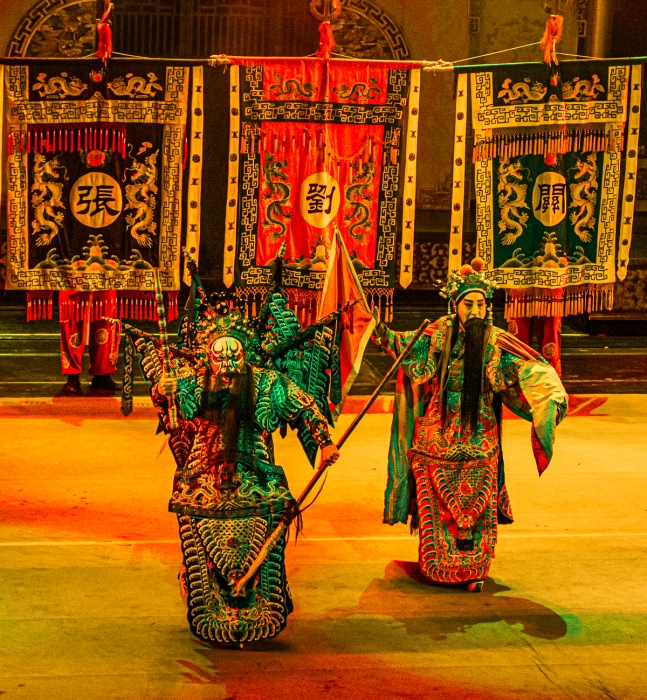

There is a powerful evil man, the villain, who wants the heroine for his bride. He vanquishes the hero and leaves him for dead. The hero survives, and the lovers are finally allowed to be together. The end.
In between all this there is what seems to be a street scene that I think may be a performance within a performance. With no other information to go on but my imagination I decide it is a show put on for the villain who must be an emperor or nobleman of some sort. We see acrobatics
table-spinning,
a puppet show
and dancing.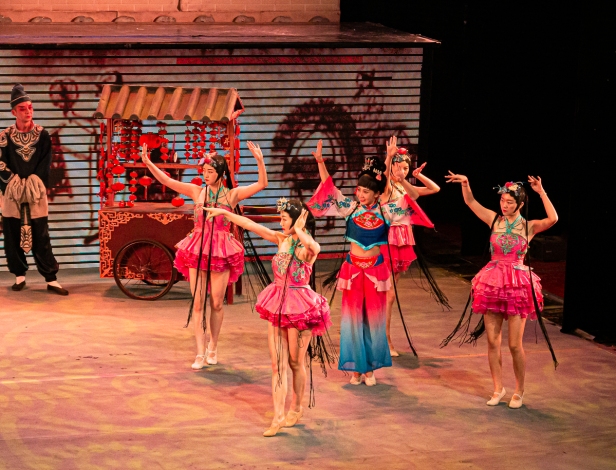
There’s a wardrobe scene with several characters interacting. It is colourful and captivating even though I haven’t a clue what it’s about,
and there are several different dance scenes

and even a downpour.
And then come the face-changing characters and fire-spitters.
In the next photo look at the mask of the character in blue, and also note the pink mask of the man with the big red epaulettes.
In the following photo the man in blue wears a different mask; it happens instantaneously.
Suddenly out of nowhere there is fire in the air.
The fire-spitters are blowing on fuel that appears to come from their mouth. Spectacular! And all the while this is happening the music is getting louder, the drums are beating, and all these characters are swirling their capes all over the stage in stylised steps and movements and changing their masks every second.
Here’s the red-epaulettes character now with an orange mask
and now black:
and another character: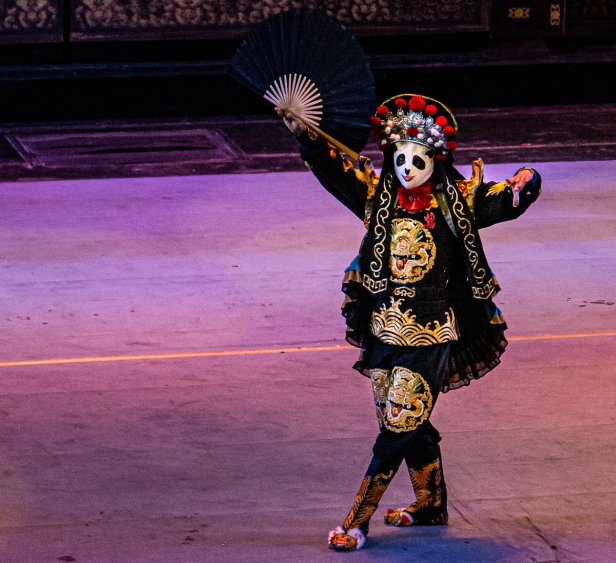

My interpretation, but it’s just a guess, is that these are the henchmen of the evil villain who’s after the heroine.
More loud music and drums and in a swirl of smoke this man appears in a green robe and mask.
With a theatrical sweep of his arms the robe drops to the floor and falls away revealing a red robe as his mask changes also to red. Another sweep of his arms and he stands instantaneously before us in an elaborate yellow costume and a black mask.
And then comes this woman who has not just a mask on her face but five on her headdress!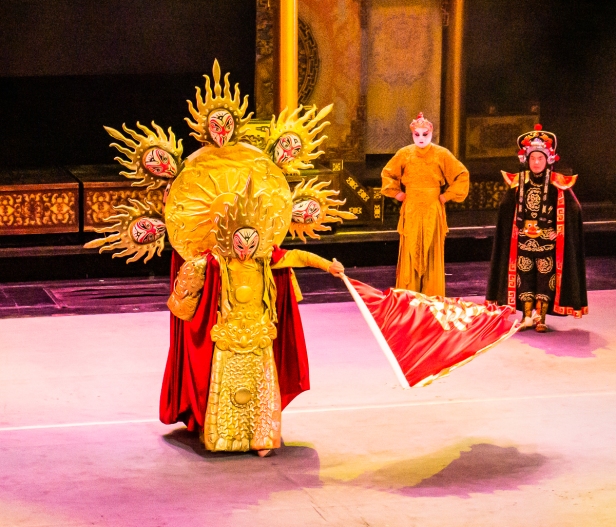
And with each roll of the drums and sweep of her big red flag ALL the masks change. Drums pounding, flag flying, and she and all the masks in her headdress have a new face again. And again. After she reveals five or six masks she retreats to the background while the whole constellation of other characters and performers come on stage for their final bows.


And at some point in the show the hero arises from the dead. I’ve seen a lot of theatre in my life. I was raised in the theatre so it has been a part of my life from when I was very young. Dance also. I don’t dance but I seek it out wherever I go as it can tell you so much about a culture. The scene where the hero comes to life is truly a moment; one of the best I’ve seen anywhere ever.
The villain and all the other characters have left the stage. The lasers and scenic projections have stopped. It is quiet. There is simply a dead man in a plain grey robe collapsed in the centre of the stage. We watch him and for a few seconds, an eternity in theatre, nothing happens. And then the slightest flutter of the fingers of one hand. Oh, he is alive! And then another flutter, like the wing of a tiny frightened bird. And then the other hand. It is a slow, powerful, believable, delicate, and deeply moving unfolding, hands, then arms, then a movement of the body, then gradually more and more until he is standing upright, unsteady and weak, but alive. It must have taken ten minutes, again an eternity in theatre, and yet it’s one of the most compelling and beautifully performed pieces of acting/dance that I’ve ever seen and it will remain with me always.
The face-changing, known as Bian Lian, is exclusive to Sichuan opera, which is more like a play than other forms of Chinese opera. The masks are family treasures showcasing ancient designs of traditional well-known characters. They are hand-painted silk and have been passed down through the generations along with the secret of how they work. The secret is that the masks are worn in layers and each mask is attached by a fine silk thread hidden within and attached to a part of the costume. A slight flick of that part of the costume or body (raising the hand, swinging the sleeve, or tossing the head) pulls on the string and removes the topmost mask revealing the next one. The actors change more than ten masks in less than twenty seconds!
The following YouTube links show some of the performance. They were not made on the night I attended (as far as I know) but it is the same show.
Next post: A three-night cruise on the Yangtze River. It’s river cruising Chinese style – questionable luxury.
All words and images by Alison Louise Armstrong unless otherwise noted
© Alison Louise Armstrong and Adventures in Wonderland – a pilgrimage of the heart, 2010-2019.

Magnificent costumes and obviously overall show! The photos you took are stunning. Incredible amount of variety and sensory stimulation. I enjoyed the video and seeing that skillful mask and costume change. One of the masks in your photos has a panda face. Love all the colors and those feathered costumes.
Fabulous post thanks for sharing you dramatic theatrical experience!
Peta
LikeLiked by 2 people
Thank you so much Peta. I was pleased with the photos considering how little light there was. I could say it was sensory overload but it wasn’t really – it was just very compelling and exciting. And of course the mask changing was a really magical thing to see.
I noticed the panda face – quite unlike the other stylized designs. Oh and the costumes were just glorious; so much beauty.
I’m glad you enjoyed the post. It was such a highlight for me that I wanted to share it and give people a little glimpse of it. If I were ever back in the area I’d go to it again.
Alison
LikeLike
what a beautiful production!
LikeLiked by 1 person
Thanks Pam. It really was. Definitely a highlight.
Alison
LikeLiked by 1 person
Amazing!!
LikeLiked by 1 person
Oh yes, definitely amazing!
Alison
LikeLiked by 1 person
The colors are beautiful. I can only imagine seeing them in person. I’m amazed at the face changes. Watching it on the videos, it doesn’t seem like they could do it that fast, but they do. So interesting!
LikeLiked by 1 person
The colours, the face-changing, the music, the acting and singing – it was all really extraordinary. I’m so glad I got to see it. I had no idea what to expect and couldn’t have imagined something so polished and spectacular. The face-changing seems plain impossible and yet they do it.
Alison
LikeLiked by 1 person
Fascinating, Alison. At first I thought the mask changes could be attributed to model electronics. To discover it is all done with silk and thread in an ancient tradition was mind blowing. What fun. And not knowing what was happening, you could focus on the costumes and make up things as you went along. 🙂 And you say you were raised in theater? What’s the story there? –Curt
LikeLiked by 1 person
Thanks Curt. The whole thing was totally fascinating. I knew nothing about it before I went and was completely blown away by it. And, yes, there was so much to look at that not completely understanding the story didn’t matter.
My parents loved theatre. Melbourne 1950’s – they were frustrated that there was no high quality live theatre for children so in their spare time (both worked full time) they founded a professional theatre company. My three sisters and I were in some of the productions, but it was all professional writers, directors, and actors. It was called the Children’s Theatre Guild of Victoria and when dad was posted to Canberra in 1962 it was absorbed into the Melbourne Theatre Company with a mandate to continue producing theatre for children. My oldest sister became an actress and then a director and has an Order of Australia for Contribution to the Arts. In Canberra my parents immediately joined the local repertory company and were active members for as long as they lived. During my early teenage years my “babysitter” was often the dressing room backstage. Also over the years I was in, or worked behind the scenes, of several productions.
Alison
LikeLike
Isn’t it great to see a production like this, when language is an unknown quantity. It stimulates looking in a different way, and the imagination takes over. Reminds me a bit of Karabuki in Japan. But they don’t have the fabulous masks there. Amazing. And as always, lovely photos.
LikeLiked by 1 person
Thanks Tracey. It was a wonderful show, and yes, really stimulated my imagination; it’s fun to make up the story as you go. The masks were just about beyond belief.
Alison
LikeLike
oh my goodness! so much beauty, such a rich and fulfilling evening that must have been! Thank you so much for sharing 🙂
LikeLiked by 1 person
Oh you’re so welcome! It was such an amazing evening I’ve been excited to share it! I’ve never seen anything like it and it was one of three truly amazing shows I saw in China. Will write about the other two in future posts.
Alison
LikeLike
Despite some of the story being lost in translation, this is such a visual feast Alison. There is just so much detail to the masks, costumes and movements. I can imagine how transfixed you were. Good for you for remembering to take photos, and such amazing ones at that.
LikeLiked by 1 person
Thanks so much Caroline. I was completely transfixed, from beginning to end, my eyes wide with excitement and the splendour of it. I did a pretty good job of not letting photography get in the way of the experience. Except when the woman stood in the aisle right near us. No way I was taking pictures of that because I didn’t want to miss a second of it, and really there was no way to capture it anyway except on video and that’s not my thing.
Alison
LikeLike
Phantasmagoric is not a word that I often use, but in this case it’s totally appropriate. Wow. I admire the fact that you were able to take photos of this mesmerizing spectacle. I would have been completely hypnotized. The layers of masks are particularly intriguing. Kind of like a metaphor for the masks we wear over our selves that change depending on those we’re with. Brilliant post, Alison. Thank you. — Julie
LikeLiked by 2 people
Oh yes! Absolutely phantasmagoric! I was completely absorbed in it and somehow managed to take photos without it being too distracting. I love your metaphor of the masks. We’re always changing according to who we’re with – but not too much I hope!
Thanks so much Julie.
Alison
LikeLiked by 1 person
The kind of performance that leaves you breathless! 🙂 🙂
LikeLiked by 1 person
Oh yes, it really was. I’m so glad I went to it.
Alison
LikeLiked by 1 person
Sounds magical and intriguing, Alison. Terrific images!
LikeLiked by 1 person
Thanks so much Jane. It was definitely both those things. I’m so glad I went to it.
Alison
LikeLiked by 1 person
Thanks for the window into this amazing world. The videos were really enjoyable after reading of your experience there. It was helpful to have your experience in my mind while watching. Even though it seems to strange and unfamiliar on the one hand, there is something about theater everywhere that is very much the same isn’t there? The acting for show, the over-done and almost cartoon-like movements. There’s something very familiar about all of that. And Julie already spoke to the very thing that was on my mind: the many faces within each of us… It’s a lovely display of how multi-faceted we are.
Peace
Michael
LikeLiked by 1 person
I was so excited to share this experience. I was on the edge of my seat for pretty much the whole show. Yes it was at times cheesy and over-the-top but also exciting and entertaining. I have always been a sucker for the big entertainment numbers, and this show was full of them. I agree about theatre everywhere – there’s a sameness to it, as if we all need and/or enjoy having this mirror held up to ourselves whether it be light-hearted comedy of heart-breaking tragedy. Somehow it’s a way of speaking the truth that makes it easier to see and absorb. The masks are a great example of this – we all have so many faces that can change in a lightening flash depending on circumstances. I remember reading about puppetry in Myanmar, how it’s a way of being political and speaking truth without actually doing either since it’s the puppet that’s doing it.
Alison
LikeLike
I wouldn’t have thought this would be such an appealing experience but your description and the photos have proven that wrong. It does sound extraordinary. The man with the gry robe – that would do it for me, too – especially coming in the midst of so much color, movement and noise – it must have been wonderful.
LikeLiked by 1 person
It was absolutely wonderful Lynn. I always seek out performance art (usually dance, but sometimes whatever else is on offer) in the countries I go to. Also I love bright colours and anything approaching spectacular. So I’m offered a chance to see Chinese opera and it’s a no brainer. I didn’t know if I’d like it or not, and knew very little about it, but curiosity always wins. I was blown away. And the coming back from death scene – so moving, so convincing. I’m really glad I went.
It’s interesting that I’ve had less “traffic” than usual for this post – I guess most people think Chinese opera would not be something they’d be drawn to. They are missing out!
Alison
LikeLiked by 1 person
You could be right about visitors’ lack of interest in the subject. That would be my feeling, but I’m really glad I read on – I learned something!
LikeLiked by 1 person
That must have been such a pleasure to watch. Chinese shows are definitely in a league of their own.
Lieve
LikeLiked by 1 person
Oh they really are. I saw four while I was there and three of them (including the Sichuan opera) left me totally gobsmacked. Definitely some of the best performances I’ve seen anywhere.
Alison
LikeLike
What a memorable production. It’s not always important to know the story of what you’re watching because that way you can let your imagination go wild. We saw a much smaller Chinese production as part of Chinese new year in Bangkok, and I made my own story up. 🙂
LikeLiked by 1 person
It was definitely memorable. I was pretty blown away by it. I pretty much made up the story, like you did. It was so entertaining that it didn’t really matter that I didn’t know exactly what it was all about.
Alison
LikeLike
I’m so impressed with the quality of your photos, not a single head in front of you blocking the view and so clear! Even without fully understanding the story this looks like the most spectacular spectacle in the true sense of the word. I feel quite exhausted just reading about it, it’s so exciting!
LikeLiked by 1 person
Thank you so much Phoebe. It was indeed a spectacular spectacle! I’m so glad I went to it.
Alison
LikeLike
Love the costume detail and the intericate details into the production.
LikeLiked by 1 person
Thanks so much Sharon. It was an amazing performance to see. The costumes alone, but then the face-changing started to happen and I was just blown away.
Alison
LikeLike
Such a descriptive post I felt I was there with you. Great accompanying photographs to really bring the story alive. Thanks for sharing it sounds a terrific show.
LikeLiked by 1 person
Thanks so much Angie. It was a really spectacular show. I’m so glad I went.
Alison
LikeLiked by 1 person
Thanks so much for sharing this lovely post with all the beautiful captures 😀
Personally love the face changing the most, really amazing experience you have gained
cheers,
siennylovesdrawing
LikeLiked by 1 person
You’re welcome Sienny, and thank you. I loved all the beautiful costumes, and the theatricality of it all, and the acrobats and dancers, but I think I too loved the face-changing to most. It was definitely an amazing experience to see it live.
Alison
LikeLiked by 1 person
Wow! It looks like they put on quite the production here! I love the costumes and the efforts with the scenery. Rain showers and fire?! Sounds like a good show to me!
LikeLiked by 1 person
It was a really amazing show. Definitely worth the money (about $50 or $60 I think). The costumes were so gorgeous, and the whole thing quite spectacular.
Alison
LikeLike
I have been to the Chengdu Chinese Opera Show. It’s very unique, and you capture it perfectly. I loved it, apart from some of the frequent high notes. LOL
LikeLiked by 1 person
Thanks Corinne. It is unique isn’t it! I just loved it. I’m so glad I went.
Alison
LikeLike
This sounds so cool, I love all the colorful vibe
LikeLiked by 1 person
It was *really* cool Fae! I’m so glad I went to it.
Alison
LikeLike
What an amazing piece of theatre & a fantastic experience. I love how you describe the action, despite not fully understanding what’s going on ;). Your photos are fantastic too. I would never normally consider going to something like this but having read your post I would be tempted!
LikeLiked by 1 person
Thank you so much Sue. It was a really spectacular evening, so I encourage you to go to something like this if you get the chance. We also went to two other evening performances in China that were just as, or perhaps even more, spectacular. It really enriched my experience of China.
Alison
LikeLike
I have only been to one opera performance before – The Phantom of the Opera. It was such an amazing experience. Thanks for sharing!
LikeLiked by 1 person
Wow, how wonderful to see Phantom live! I imagine it was really powerful.
Alison
LikeLike